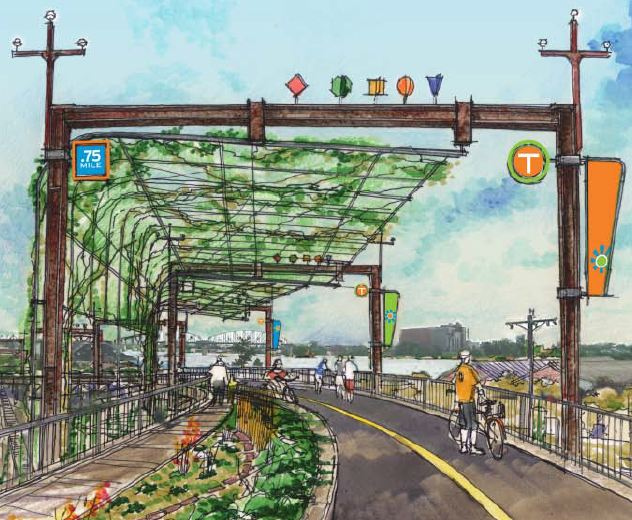 It was the best of times, it was the worst of times. That's a bit melodramatic, but the story of elevated parks in New York and St. Louis is truly a tale of two cities. New York's High Line, its saving, transformation and end result, has been lauded in every major news and design publication. National Geographic titled it the "Miracle Above Manhattan". And it should be celebrated. Opened in 1934, the elevated tracks eliminated 105 grade crossings in NYC. A portion was demolished as early as 1960 and the line was abandoned in 1980. A grassroots effort to preserve the structure began in 1999, ultimately receiving support from Mayor Bloomberg. The first section opened as a park in 2009.
It was the best of times, it was the worst of times. That's a bit melodramatic, but the story of elevated parks in New York and St. Louis is truly a tale of two cities. New York's High Line, its saving, transformation and end result, has been lauded in every major news and design publication. National Geographic titled it the "Miracle Above Manhattan". And it should be celebrated. Opened in 1934, the elevated tracks eliminated 105 grade crossings in NYC. A portion was demolished as early as 1960 and the line was abandoned in 1980. A grassroots effort to preserve the structure began in 1999, ultimately receiving support from Mayor Bloomberg. The first section opened as a park in 2009.
Urban elevated railways aren't rare. While many have been demolished, many can still be found, especially in older cities with central rail lines that served a once vibrant manufacturing base. In St. Louis, the elevated track is simply referred to as the Trestle. As City Garden's albatross will always be the comparison to Chicago's Millennium Park, the Trestle seems destined to be saddled with never-ending references to the High Line. Such a comparison is not only incorrect, it's terribly detrimental to St. Louis's effort to preserve and reuse the Trestle.

{the High Line being enjoyed by tourists and residents alike}

{the vision for southern landing of the Trestle}

{the southern landing as it appears today}
St. Louis is not New York. Repeat 5x. Simple. Manhattan has 71K residents per square mile. St. Louis? 5K. So why are the High Line and the Trestle set as kindred efforts? Physical form is not enough to ignore cultural, commercial and contextual factors. In fact, urban planning, renewal and development efforts routinely suffer and fail for a lack of context. Why do the renderings of the Trestle show a pedestrian walkway with a multitude of benches and other amenities more akin to the High Line than a lightly used bike path through a sparsely used industrial zone? To be sure, the images created by the HOK Planning Group are more vision than plan, yet they set an unrealistic tone that will ultimately disappoint. This is why the adopted new urbanist refrain of, "St. Louis should be the best St. Louis it can be," rings true in this instance (and many others).

{the High Line in Manhattan's Meatpacking District}

{the Trestle traverses the sparse light industrial zone of St. Louis' north riverfront}
A recent article in the Post-Dispatch takes up the erroneous framing of the project, "New York has the High Line, and Paris has the Promenade Plantée. Both are lush linear parks on top of old railroad trestles. They snake through urban landscapes and attract millions of pedestrians a year. If the Great Rivers Greenway District has its way, St. Louis will have one too." The Trestle will not attract millions, new hotels will not be built straddling the elevated park, as has been done in New York. The city has committed to keeping the land traversed by the Trestle as light industrial and warehousing.
So what should the Trestle become? The simple, functional $12M McKinley Bridge Bikeway is a good example. The northern end of the Trestle would meet the Bikeway, and serve as a connection to both the North Riverfront Trail and the McKinley Bridge and Illinois. Riding the Bikeway is a great, if brief experience. As a city, we are surprisingly disconnected from our working waterfront, the largest inland port in the nation (unless you count Houston). Extending that experience with the Trestle would offer the best bike path in the city and reconnect the near north neighborhoods with the river.

{the McKinley Bridge Bikeway could be a model for the Trestle}
The first two sections, 1.5 miles, of the High Line cost $152M to transform. In St. Louis, Great Rivers Greenway, the region's bicycle and pedestrian connection authority, purchased the 1.5-mile Trestle for $1.5M in 2004. There was little threat of demolition. For better or worse, much of St. Louis is inexpensive and is left standing until it falls on its own. The organization often takes advantage of what has traditionally been referred to as "rails to trails", repurposing unused rail lines as linear parks, and completed the McKinley Bridge Bikeway project.

{the vision presented for the Trestle is inspiring, but does it work?}
As inspiring as it may be, comparisons to the High Line and the Promenade Plantée in Paris are misleading and potentially damaging. I believe it is incredibly important to create new connections in our city scarred by innumerable barriers and the Trestle should be put back into use as soon as practical. To do this we need not aspire to replicate unrelated projects in others cities. Let's not wait for a $100M City Garden in the sky. We need to create a public space for St. Louis, by St. Louis and of St. Louis, and celebrate that.


